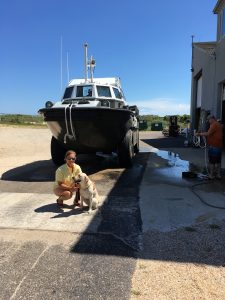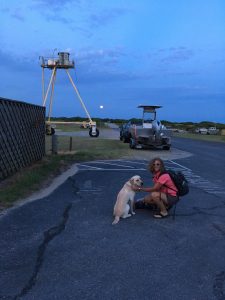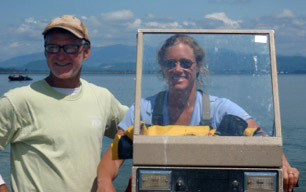Someone recently asked me “how exactly does Hugger help with your work?”

Hugger and me in front of the Army Corps’ Larc, which is outfitted with radar, GPS, sonars, and other equipment. The Larc is used often to deploy instruments, and to survey sand levels along the coast. We walk past the Larc high-bay and washing area to get from our equipment van to our office and the dive locker – Hugger makes sure I don’t get in the way, or under the wheels!
For example, Hugger has been guiding me around the Army Corps Field Research Facility, avoiding all the equipment and vehicles that get moved around. Without Hugger, I’d be a hazard that others would need to watch out for.
We can walk from our house to the field site along the Duck, NC boardwalk, which zigs and zags thru the marshes and along the shops. There are joggers and walkers and shoppers everywhere. Without Hugger I would want someone to drive me.
Yesterday, after I finished a phone-meeting with colleagues, Hugger guided me from our office to our beach sampling site to join the crew, which enabled everyone to keep working rather than sending someone to pick me up.

A beautiful full moon setting in the west, behind the Army Corps’ boat, used to maintain instruments in the sound, and the Coastal Research Amphibious Buggy (CRAB), which we use often to deploy instruments in the ocean surf zone. The CRAB motor is on the upper platform, which is 25 feet above the ground, enabling it to drive out to 24 feet water depth, and giving us a stable platform even in large breaking waves (where a small boat is unsafe).
I also was asked “why do most of the photos show Hugger without a harness?” Hugger allows me to be independent, so we’re often on our own when she’s working – there’s nobody to take a photo. When we meet up with our field group, she gets to rest, play, and pose for photos!
I could change the way I do my work by sending others to the field without me, or not traveling to as many conferences or meetings. But one of the things I love about my career is the variety. And going to the beach! Hugger makes both possible.


